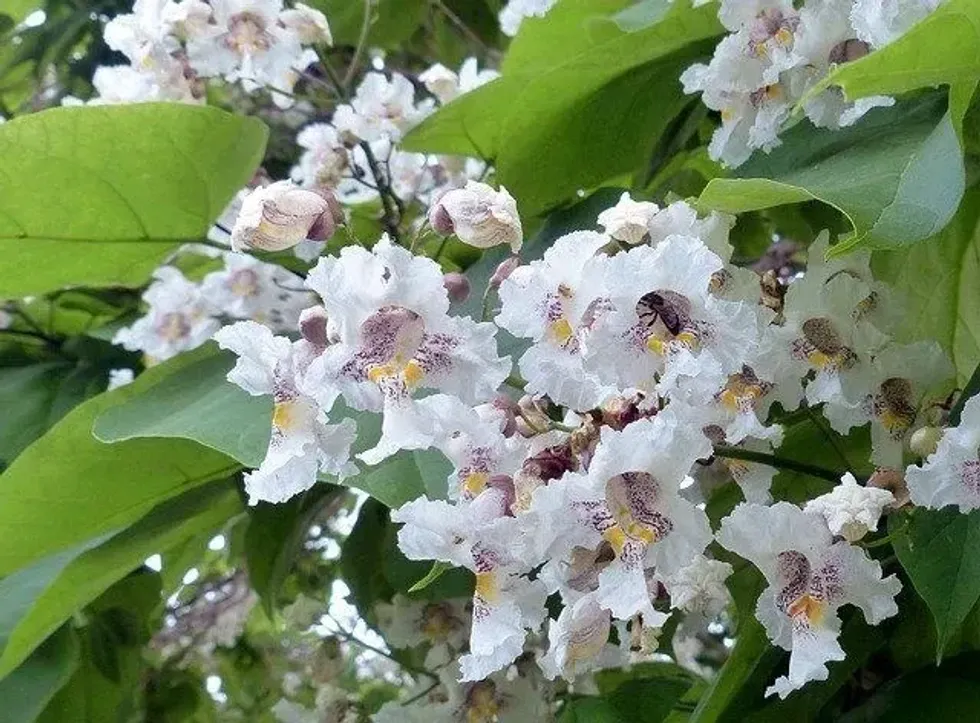Northern Catalpas are a species of tree native to the United States.
They are typically found in the midwestern parts of the country. Northern Catalpas can reach heights of up to 60 ft (18.28 m) and have a canopy spread of up to 40 ft (12.19 m).
The scientific name for the Northern Catalpa is Catalpa speciosa and belongs to the Bignonia family. This tree experiences rapid growth in the first ten years of its life, and then gradually, it begins to slow down.
Catalpa generally means Indian bean tree or cigarette tree because of the long and cylindrical shape of its fruit. The Catalpa often attracts the Catalpa Sphinx Moth, and these moths lay their eggs on these trees.
Northern Catalpa trees have large heart-shaped leaves. The leaves are green on top and paler underneath.
The bark of a Northern Catalpa tree is smooth and gray, with deep furrows running along its length. The branches of a Northern Catalpa are often crooked, giving the tree a distinctive appearance. The most common Catalpa species are the Chinese Catalpa, Southern Catalpa, and Northern Catalpa.
Northern Catalpa Tree Habitat

Northern Catalpas are native to the United States, from the lower midwest and southern states. Northern Catalpa trees can also be found growing throughout much of the Midwest and into Western Texas.
They grow in USDA hardiness zones of four through nine, covering most of the country except for parts of Alaska and Maine.
Northern Catalpas (Catalpa speciosa) prefer full sun and moist, well-drained soil to thrive but can tolerate various conditions, including poor quality soils or drought stress, as long as they receive enough water during their first few years after planting. Northern Catalpas are also tolerant of clay and compacted soils.
These trees can also be found in the wild from New York west to Iowa, south through Texas, and east into Florida or Georgia.
Characteristics Of The Northern Catalpa Tree
Northern Catalpa (Catalpa speciosa) trees prefer full sunlight but will tolerate partial shade as long as they get at least six hours per day. This tree also goes by other names like Indian bean tree, cigar tree, western Catalpa, caterpillar tree, or hardy Catalpa.
Northern catalpas need a lot of water during their first few years after planting; however, once established, they become drought tolerant and do not need much additional watering except under extreme conditions such as ongoing periods without rain over several weeks, which can cause them stress even if it has been raining regularly recently before that time period started.
Northern Catalpa trees have numerous practical applications as well. Their wood is strong and durable, making it suitable for construction purposes such as building houses, furniture, or cabinets. The bark is also used to make firewood because it burns hot and slow.
Growth Requirements Of The Northern Catalpa Tree
Northern Catalpas are fast-growing and long-lived trees that provide important benefits to wildlife. They make a good choice for homeowners who want an attractive tree that doesn't require much maintenance or care.
Northern Catalpas prefer full sun but can tolerate some shade. They grow best in moist, well-drained soils and adapt to a wide range of soil types. Northern Catalpas require little maintenance once they are established, but it is important to water them during times of drought.
They can be grown in almost any soil type, including clay or loam, but they do best when planted in a sunny location with plenty of space around them so that their roots will not become compacted. Alkaline soil is preferably the best.
The trees should always have good air circulation to prevent fungal problems like powdery mildew from developing on their leaves (during damp weather conditions).
Fruits And Flowers Of The Northern Catalpa Tree
Northern Catalpa (Catalpa speciosa), or cigar tree, is an ornamental tree, shade, and food producer.
Their dangling seed pods that look like beans, their heart-shaped leaves, and their elegant appearance can easily catch your attention. The leaf is very similar in shape to an elephant's ear too!
Northern Catalpa trees are prized for their beautiful white flowers with yellow stripes and purple spots on the inside, which appear in late spring or early summer.
The blossoms are large and bell-shaped and have a sweet fragrance that can be smelled from some distance away. The white flowers and the seed pods are beneficial for insect pollinators like bees.
The tree produces an abundance of fruit enjoyed by many different animals, including deer, raccoon, opossum, skunk, and striped squirrels. A ripe catalpa fruit turns brown and slippery when they fall to the ground. Therefore, you should not plant them in areas where people walk as it can lead to accidents.
FAQs
Are catalpa tree roots invasive?
Northern catalpas are known for their aggressive root systems that can easily invade underground plumbing. They grow deep taproots that spread far from the trunk, and these roots tend to be shallow, making them prone to damage during construction work or any other type of digging project.
Northern Catalpa trees also have system branches extending outward from the main stem at a 90-degree angle.
Are catalpa tree beans edible?
Yes, the beans of the Northern Catalpa tree are edible. They can be eaten raw or cooked and have a sweet and nutty flavor. Northern Catalpa beans are an excellent protein, fiber, and minerals source. They can be used in soups, stews, other dishes or enjoyed as a healthy snack.
What is unique about a catalpa tree?
There are many Northern Catalpa tree facts, but perhaps the most interesting is how it reproduces. Northern catalpas do not produce seeds or nuts like other trees. Instead, their flowers develop into long, bean-like pods that can grow up to 18 in (45.72 cm) in length and contain dozens of flat seeds with winged edges.
These 'beans' will drop from the Northern Catalpa tree in late summer or fall and be dispersed by wind or animals like squirrels, birds, and raccoons. When they land on soil Northern Catalpas, germinate readily, sprouting seedlings wherever they fall onto bare ground.









